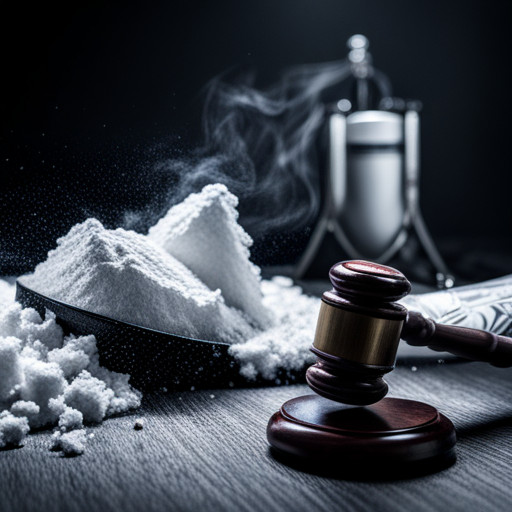Talcum Powder
Like a double-edged sword, talcum powder serves an array of industries for its unique properties, while its potential health risks stir controversy. This piece investigates talc's origins, uses, and associated health concerns, including its potential link to ovarian cancer and respiratory issues. We also delve into product recalls due to asbestos contamination, the inconsistency of warning labels, and the debate surrounding talc alternatives. Join us as we unravel the complexities of this ubiquitous, yet contentious powder.

Key Takeaways
- Talcum powder is made from talc, a naturally occurring silicate mineral that is used in a variety of industrial and cosmetic products.
- There is a potential link between talcum powder use around the genital area and an increased risk of ovarian cancer, although the FDA has not made a conclusive determination.
- Talcum powder can also cause severe lung damage and breathing problems if inhaled, and has been linked to respiratory problems, lung cancer, talcosis, asthma, and pneumonia.
- Johnson & Johnson has faced recalls and lawsuits related to talcum powder contamination with asbestos, a cancer-causing substance that can naturally occur with talc. The company has announced it will stop selling talc-based baby powder globally in 2023, but denies any safety concerns.
Understanding Talcum Powder
To gain a comprehensive understanding of talcum powder, it is critical to examine the numerous facets of its production, application, potential health risks, and the ongoing controversies and legal battles surrounding its use. Talcum powder, derived from the softest mineral on earth, talc, has a rich history that dates back to ancient civilizations. The historical use of talcum powder for personal hygiene and industrial applications has solidified its presence in households and manufacturing units. However, the environmental impact of talc mining has been a subject of concern. Extraction processes can lead to deforestation, loss of biodiversity, and soil erosion. Additionally, the energy-intensive nature of talc processing contributes to greenhouse gas emissions. Therefore, the sustainability of talc mining is under scrutiny, prompting a need for regulation and alternative solutions.
The Origins and Manufacturing of Talcum Powder
While talcum powder is widely known for its use in various consumer products, it is the process of its origin and manufacturing, starting from the extraction of the raw mineral talc, that truly underpins its broad applicability and ongoing controversies. The mining of talc inflicts a significant environmental impact, often disrupting local ecosystems and contaminating water sources. After extraction, talc is crushed, dried, and milled into a fine powder, ready for use in a multitude of products. The cultural and historical uses of talcum powder are diverse, ranging from personal hygiene to pharmaceutical applications, underscoring its pervasive presence in daily life. Nevertheless, its production process and wide usage remain subjects of scrutiny owing to associated health and environmental concerns.
Uses of Talcum Powder in Various Industries
How extensively is talcum powder employed across different industries, and what specific roles does it fulfill in each of these varied contexts? Talcum powder, owing to its properties of moisture absorption and friction reduction, is utilized extensively in various sectors. The food industry, for instance, uses talcum powder as an anti-caking agent. Despite its utility, the environmental impact of talcum powder production cannot be overlooked. The mining and milling processes involved can lead to land degradation and water pollution, posing a serious challenge to environmental sustainability. In the cosmetics industry, talcum powder serves as a texture enhancer and is widely used in beauty products. In the pharmaceutical industry, it's used as a lubricant, ensuring tablets don't stick during production.
Famous Brands and Products Containing Talcum Powder
In the realm of cosmetics and personal care, several well-known brands incorporate talcum powder in their products, and these include Johnson & Johnson, Nivea, and Revlon, among others. These brands have been at the center of famous talcum powder lawsuits, mainly due to the potential side effects of talcum powder. Johnson & Johnson, for instance, has faced multiple legal battles linking its talc-based products to ovarian cancer. Meanwhile, Nivea and Revlon have also received scrutiny for their use of talcum powder in certain products. Despite these controversies, these brands continue to hold a significant market share. Consumers are, however, urged to stay informed about the potential side effects and make decisions based on their individual health considerations.
The Association Between Talcum Powder and Health Concerns
Numerous studies have raised concerns about the potential health risks associated with talcum powder use, and these range from respiratory issues to more serious conditions such as ovarian cancer. A significant body of research focuses on talcum powder and its impact on female reproductive health. Long-term use of talcum powder in the genital area has been linked to an increased risk of ovarian cancer. Additionally, talcum powder use in infants has been associated with potential health risks. Inhalation of talcum powder can lead to respiratory problems in infants, including pneumonia and asthma. Despite these concerns, more definitive research is required to establish a clear link between talcum powder use and these health issues.
The Link Between Talcum Powder and Ovarian Cancer
Despite ongoing debates within the scientific community, a correlation between the use of talcum powder, particularly in the genital area, and an elevated risk of ovarian cancer has been suggested by various studies. This has led to the exploration of 'Talcum powder and ovarian cancer: Risk factors and prevention'. Research indicates that long-term use of talcum powder in the genital area significantly increases the risk of ovarian cancer. As a prevention strategy, women are advised to avoid using talcum powder in the genital area. The discovery of this correlation has also given rise to numerous lawsuits, prompting discussion on 'Talcum powder litigation: Legal implications and compensation options. Victims have sought legal recourse, with some successful in securing compensation for their suffering.
Talcum Powder and Respiratory Diseases
Talcum powder, when inhaled, can lead to respiratory diseases, and this potential risk has stirred considerable concern within the medical community. The link between respiratory diseases and talcum powder has been the subject of numerous studies, revealing that prolonged and regular inhalation can result in lung damage. The tiny particles can lodge in the lungs, causing inflammation and scarring, conditions that can eventually lead to respiratory ailments such as chronic bronchitis, asthma, and even lung cancer. Moreover, workers involved in the mining and milling processes of talc have demonstrated an elevated risk of developing these diseases. Thus, while talcum powder has many beneficial uses, it is crucial to be aware of its potential health risks, especially regarding respiratory health.
Research and Studies on Talcum Powder’s Health Impact
Over the past few decades, and particularly within the last ten years, significant research has been conducted on the health impact of talcum powder, and these studies have brought to light some potentially serious health risks associated with its use. Notably, it has been suggested that talcum powder's impact on reproductive health could be substantial, with several studies associating its use with an increased risk of ovarian cancer. Furthermore, concerns have arisen regarding the potential long-term effects of talcum powder use. Some research indicates a potential link to the development of lung disease and other respiratory issues. However, more definitive research is needed to fully understand this complex issue and confirm these potential health risks.
Controversies Surrounding Talcum Powder
While talcum powder has been a staple in many households for decades, it has been mired in controversy due to allegations regarding its potential health risks and reported cases of contamination. This has led to significant economic impact as consumers move away from talc-based products, leading to declining sales and companies discontinuing their talc-based lines. The role of media in shaping public perception of talcum powder controversies cannot be underestimated. Media coverage has heightened public awareness, influencing consumer behavior and contributing to mounting legal challenges against talc manufacturers. This has resulted in massive legal settlements, further exacerbating the economic fallout for companies involved. Despite these controversies, regulatory action has been slow, sparking further public debate about the safety of talcum powder.
Recalls and Asbestos Contamination in Talcum Powder
How has the issue of asbestos contamination led to recalls of talcum powder products? The presence of this carcinogenic substance in talcum powder has raised grave health concerns, prompting several manufacturers to recall their products. The most notable case involved Johnson & Johnson, who recalled 33,000 bottles of their baby powder in 2019. This move had significant legal implications, as it added fuel to the thousands of lawsuits claiming their products caused cancer. These recalls have also impacted the public perception and trust in talcum powder manufacturers. Many consumers now perceive these products as harmful, causing a shift towards alternatives. Consequently, manufacturers are combating both legal battles and a damaged reputation, underscoring the far-reaching impact of asbestos contamination in talcum powder.
Corporate Actions and Statements on Talcum Powder Safety
As the controversy surrounding the safety of talcum powder continues to escalate, many corporations have made public statements and taken specific actions to address these concerns. Embracing corporate responsibility, companies like Johnson & Johnson have voluntarily recalled products suspected of asbestos contamination. They have also initiated research and sought external consultation to investigate the safety of their talcum powder. Some corporations have ceased the manufacture of talc-based products entirely due to potential legal implications. Despite these actions, many argue that corporations could do more to ensure product safety and transparency. This includes sharing safety test results, collaborating with regulatory bodies for stringent safety protocols, and proactively warning consumers about potential health risks associated with talcum powder use.
Regulatory Laws and Guidelines for Talcum Powder
Where do regulatory laws and guidelines stand in relation to talcum powder, and what are the implications for manufacturers and consumers alike? The laws and regulations regarding talcum powder safety currently demand that it should be free from asbestos, a known carcinogen. However, the U.S. Food and Drug Administration (FDA) doesn't have the authority to mandate testing or to guarantee the absence of asbestos in talcum powder products, leaving it largely up to manufacturers to ensure product safety. This lack of stringent regulation opens up potential legal implications for talcum powder manufacturers, as they could face lawsuits if their products are found to be contaminated. Consumers, on the other hand, are left to trust the safety assurances provided by manufacturers, which could have serious health implications.
The Absence of Warning Labels on Talcum Powder Products
Despite mounting evidence suggesting potential health risks associated with talcum powder use, many manufacturers continue to distribute their products without any form of warning labels. This absence has led to numerous legal implications, including lawsuits and settlements related to talcum powder products. Manufacturers' reluctance to provide adequate information about potential risks has sparked public outcry and inspired public awareness campaigns. These initiatives aim at educating consumers about the potential health hazards associated with talcum powder use. The absence of explicit warning labels on talcum powder products remains a contentious issue, highlighting the need for more transparency from manufacturers and more stringent regulations from health authorities. The ultimate goal is to ensure consumer safety and promote informed decision-making in product use.
Alternatives to Talcum Powder in the Market
Considering the potential health risks associated with talcum powder, many consumers are turning to alternative products currently available in the market. These alternatives, ranging from cornstarch to zinc oxide, offer the benefits of talc-free skincare products, including reduced health risks and enhanced skin health. The boom in consumer awareness and education about talcum powder alternatives is driving this shift. More people are now aware of the potential health risks linked to talc and are making informed choices. Brands are also responding to this demand by developing and promoting talc-free products. However, while these alternatives offer numerous benefits, it is vital for consumers to understand their varying hazard levels and potential side effects before making a switch.
Consumer Advice on Talcum Powder Usage and Alternatives
Frequently, consumers are advised to exercise caution when using talcum powder due to the potential health risks associated with its use, and to consider safer alternatives when available. In line with talcum powder safety, it is particularly important to avoid inhalation and to keep it away from children's reach. This is crucial because talcum powder and baby care often go hand in hand, yet pediatricians recommend against its use on infants due to risk of respiratory issues. Cornstarch-based powders have been identified as a safer alternative, as they do not contain the potentially harmful elements found in talc. However, it is recommended to consult with a healthcare professional before making any changes to personal or baby care routines.
Frequently Asked Questions
What Is the Process for Filing a Lawsuit Against Talcum Powder Manufacturers?
The process for filing a lawsuit against manufacturers involves several steps. Firstly, potential claimants should consult with a legal expert to evaluate their claim eligibility. The attorney will review case specifics, including product usage and medical history. If the case is viable, the legal team will file the lawsuit and bear upfront lawsuit costs. The process may involve negotiations, discovery, and potentially a trial. It's essential to act promptly due to statutes of limitation.
How Does the Use of Talcum Powder Affect the Environment?
The exploration of environmental consequences arising from product usage is crucial in our eco-conscious era. Specifically, talcum powder, a widely used product, presents challenges in waste management due to its extensive use and disposal. Its production process may lead to deforestation and habitat destruction, while waste can contaminate water sources. Furthermore, its mining activities emit greenhouse gases. Therefore, the environment bears a significant impact from the lifecycle of talcum powder, necessitating further investigation and remedial strategies.
Are There Natural Alternatives to Talcum Powder That Can Be Made at Home?
Yes, there are natural alternatives to talcum powder that one can make at home. DIY deodorants are often made with ingredients like baking soda, arrowroot powder, or cornstarch. Cornstarch applications are especially popular due to their moisture-absorbing properties, which closely mimic those of talcum powder. It's important to note that while these alternatives are generally considered safe, individuals should still test any DIY product on a small patch of skin to check for sensitivities.
How Are Talcum Powder Manufacturers Responding to the Health Concerns Raised?
In response to health concerns, manufacturers have made industry adaptations and demonstrated reformulation progress. For instance, Johnson & Johnson discontinued their talc-based baby powder in North America, transitioning to cornstarch-based products. Other companies are researching and developing safer alternatives to talc. This proactive approach highlights the industry's commitment to prioritizing consumer safety while still providing high-quality products. However, the full impact of these changes remains to be seen as research continues.
Are There Any Ongoing Clinical Trials Studying the Effects of Talcum Powder?
Ongoing clinical trials studying the effects of various substances are crucial in gaining insights into potential health risks. As concerns over talcum powder have grown, research in this area is vital. It is currently unclear whether any specific trials are underway focusing on talcum formulation changes and associated health risks. However, the heightened health risks awareness surrounding talcum powder is likely to encourage further scientific investigation. It is recommended to regularly check clinical trial databases for updates.
Conclusion
The discourse surrounding talcum powder underscores the intricacies of striking a balance between industrial utility and health implications. The association of talc with serious health risks, the inconsistency in regulatory measures, and the challenges posed by alternatives underscores a complex conundrum. As consumers navigate this labyrinth, prudence in usage and vigilant exploration of alternatives become integral. Ultimately, the debate on talcum powder serves as a reflective mirror on the broader dynamics of product safety, industrial profits, and consumer health.

This post has been generated by AI and was not reviewed by editors. This is Not legal advice. Please consult with an attorney.




